Utah, known affectionately as ‘The Beehive State’, has 3 major regions that help to make for excellent birding possibilities. These include the Colorado Plateau, the Basin and Ridge Region, and the Rocky Mountains, ensuring that the scenery is beautiful, diverse, and ready to host happy local birds and visitors from all over North America. Today we’ll take a closer look at the popular backyard birds of Utah and give you the scoop on some Avian species that you can spot, lure, or even visit at hotspots located throughout the state. Without further ado, let’s talk about Utah birds and birding!
3 Categories – 466 Birds
Those 3 regions we mentioned do indeed promote Avian diversity and as such, Utah is home either full or part time to an impressive 466 species of bird. Today we’ll introduce you to a few of those species which we will divide up seasonally like this:
- Year-round Resident birds
- Birds of Spring, Summer, and Early Fall
- Fall and Winter Birds
We’ll give you identification tips as well as some feeder advice and with a little patience you might just lure some new visitors into your backyard. Let’s start our introduction to Utah birds with the year-round residents.
Utah’s Year-round Resident birds
These birds make Utah their home and you can spot them year-round. With a nesting box, some species will even move in to your backyard! Take a look and see if you can spot or lure in one of these birds this year:
- Black-Billed Magpie
- European Starling
- Mourning Dove
- House Finch
- American Robin
Black-Billed Magpie – Pica hudsonia

Coloration and Markings: Black-billed Magpies have black backs with white ‘backpack straps’ present, giving the shoulder a black and white look, but their wings will be medium-length and mostly a mix of deep blue with black highlights towards for the inner portions of the wings while the outer half towards the tips will be white. They have long, blue black tails which fan in a diamond shape when the bird is in flight and the underbelly of this bird is mostly black with some white at the rump. The breast will be white and facially, this bird is completely black with a long, straight black bill that exhibits a light curvature in the upper bill.
Size: Roughly Crow-sized, these are big birds measuring in at 17.7 – 23.6 inches in length and having wingspans of 22.1 to 24 inches.
Habitat: Magpies are often found near rivers and streams but they also visit farms and cities quite often. They will visit backyard feeders but don’t be surprised if they bring friends along. These birds like to travel in flocks.
Diet: Black-billed Magpies will eat just about anything. Chopped up strawberries or cherries, suet, peanuts, and even pet food if they see it outside.
European Starling – Sturnus vulgaris
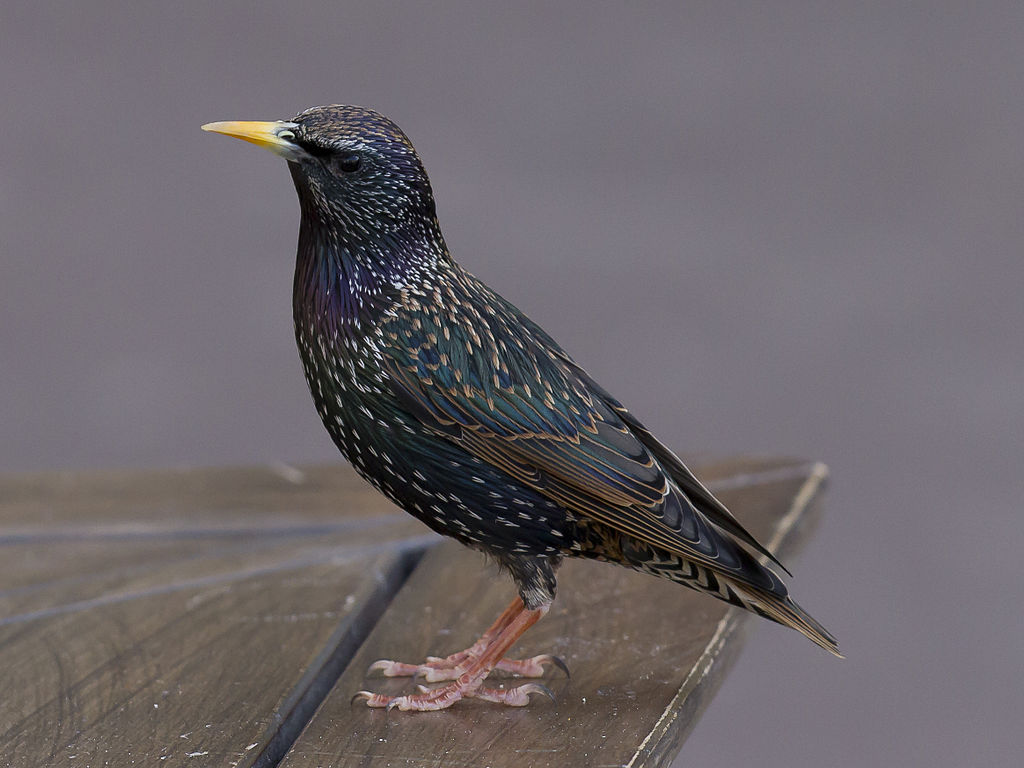
Coloration and Markings: The European Starling is easy to recognize. While they might look like any old Blackbird from a distance the long, straight yellow bill is your first clue. Close up, you can see that their plumage is actually a mix of purples and greens. They have short tails, which makes their medium-sized wings look rather long until you see them in flight. In the winter you can also expect a costume change, as they trade in their shiny purple-green for a coat of brown with striking white spots.
Size: About the same size as your average Robin, these birds measure in at 7.9 -9.1 inches in length and have wingspans of 12.2 to 15.8 inches.
Habitat: European Starlings can sometimes be found in fields but seldom in the woods, as they prefer human settlements. Look for them in farms, towns, and cities, where they are often perched on phone lines or fences as they scope out the environment for snacks.
Diet: These guys love suet, peanuts, wheat, and rolled outs. Watch your suet, however, as they tend to focus on this alone and can eat you out of house and home if you let them.
Mourning Dove – Zenaida macroura
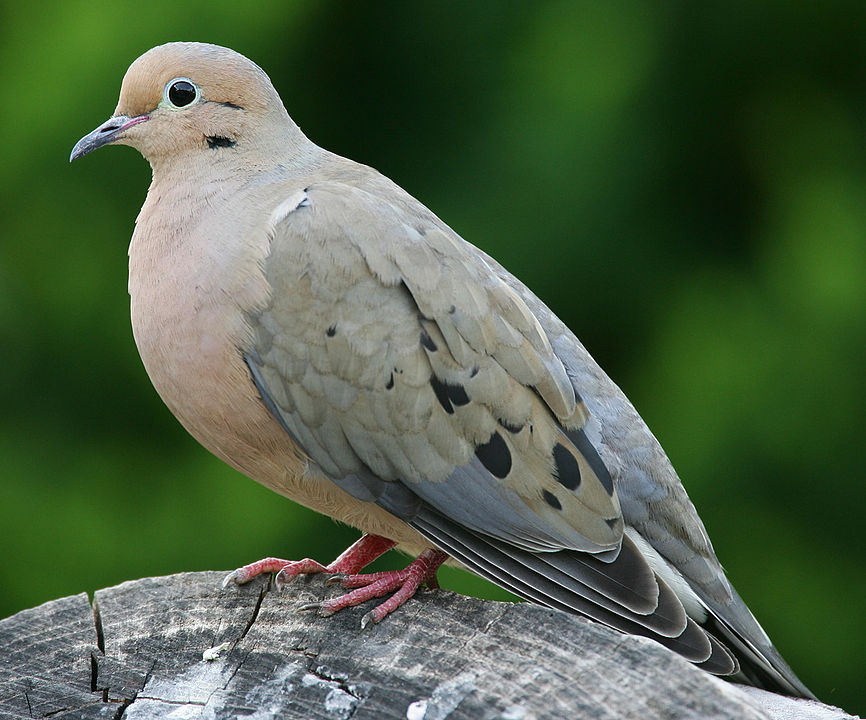
Coloration and Markings: Mourning Doves are plump, gray, and tan. They have gray backs with long, gray wings which bear a concentration of buffy tan coloration towards the centers along with some delightful and large black spots. They have long, pointy gray tails and their breast and underbelly is white with a heavy infusion of creamy tan color. Facially, you will see the most buffy color concentration and this really brings out an almost cartoonish white eyering. This bird has a medium length, straight black bill.
Size: Another Robin-sized bird, this Dove measures in at 9.1 – 13.4 inches from head to tail and has a wingspan approximately 17.7 inches wide.
Habitat: These birds turn their bills up at the deep woods, preferring to spend their time in fields and other open areas. Most of the time, however, they prefer farms or the city. You can see them on fences, sidewalks, and phone lines and they will certainly visit your backyard if they notice that you’ve left a little something out for them.
Diet: Nyjer thistle, Black Oil Sunflower seeds, and a little cracked corn are all that you need to make a very happy Dove.
House Finch – Haemorhous mexicanus
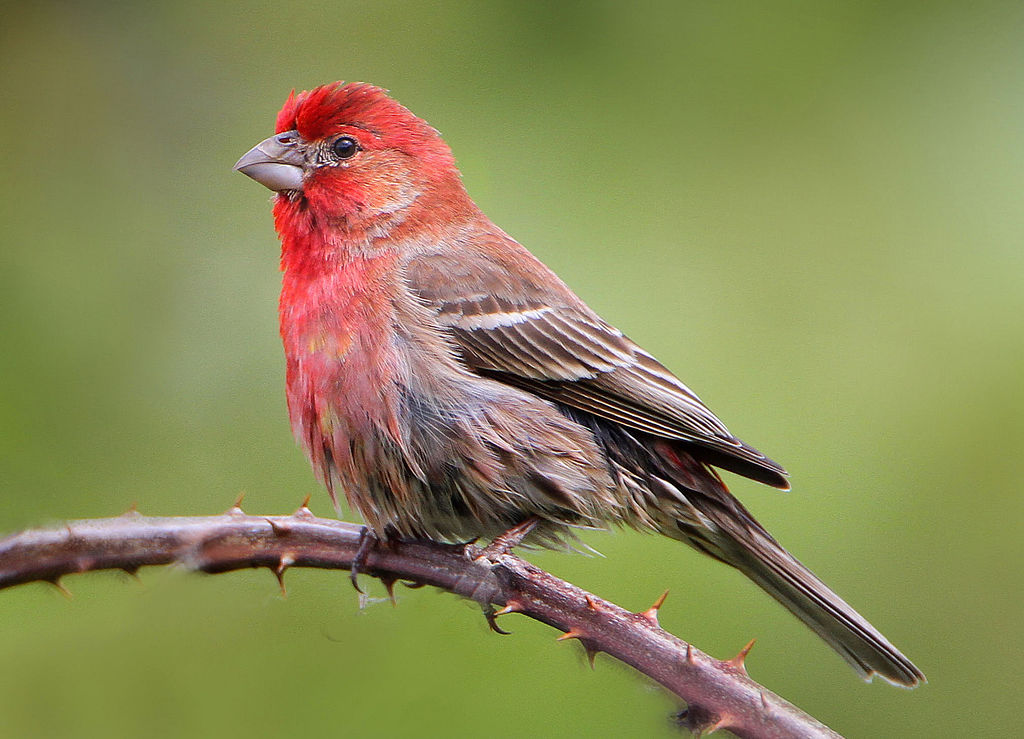
Coloration and Markings: Male House Finches are easy to identify. They have grayish backs with dark brown to black streaking and this shows on their short wings as well, where you can also see 2 thin, white wingbars. They have medium-length gray tails with white on the outer feathers and the underbelly of this bird is white with dark streaking. As the color moves up towards the breast the streaking is replaced by a rosy-pink saturation that mostly fills the breast and carries up into the face, where you will see it at the throat, chin, and just in front of the cheeks, as well as on the top of the head and the back of the neck. A gray eyeline travels through the eyes and splits, with one line going towards the lower back of the neck and another curling around to frame the cheek. This bird has a small, stout silver bill with a noticeable curvature on the upper bill.
Size: These birds measure in at 5.1 – 5.5 inches in length and have wingspans of 7.9 to 9.8 inches.
Habitat: House Finches may be found in a number of environments, such as deserts, grasslands, chaparrals, and at the forest’s edge. They also aren’t so shy of humans, being frequent visitors to parks, farms, and residential backyards in the city.
Diet: Suet and White Proso millet are both popular with House Finches and their addition to your feeders might just make you a new friend!
American Robin – Turdus migratorius
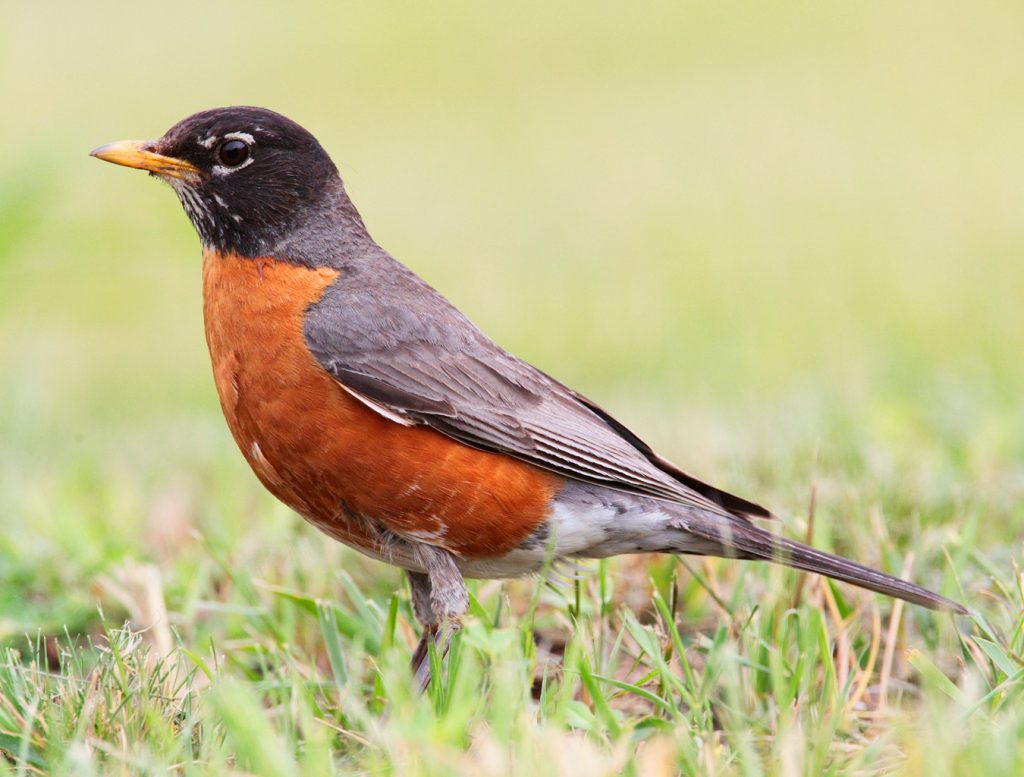
Coloration and Markings: American Robins have brownish-gray backs with long wings and tails of the same color, though you will note some white on the underside of the tail from the white rump. The breast and underbelly are a reddish-orange color and facially, the Robin’s head is black. This black color is only broken by a fragmented white eyering and a medium-length, curved yellow bill that is sometimes tipped with a little black. Females will display the same coloration but with must less contrast of color displayed.
Size: These birds measure in at 7.9 – 11 inches from head to tail and have wingspans of 12.2 to 15.8 inches in width.
Habitat: These birds love deciduous and pine forests, though they venture often into parks, golf courses, shrublands, and backyards. Keep an eye out, these birds can be found just about anywhere and they are well worth the time it take to get a closer look.
Diet: Mix some crushed peanuts with raisins and some chopped apples on the side. Your local Robins will love you for it.
Utah’s Birds of Spring, Summer, and Early Fall
When the rivers start getting louder and the Sage and Tulips are starting to show themselves then spring has arrived in Utah. During this time a number of Avian visitors will be making an appearance, typically sticking around until early fall. See if you can spot one of these birds during the warm season this year:
- Black-chinned Hummingbird
- Barn Swallow
- Yellow-headed Blackbird
- Marsh Wren
- Bullock’s Oriole
Black-chinned Hummingbird – Archilochus alexandri

Coloration and Markings: Male Black-chinned Hummingbirds can sometimes appear almost completely black, with a black head, back, underbelly, and breast, but more commonly they will have metallic green backs with medium-length, green-shouldered black wings and short black or metallic green tails. The underbelly of this bird is grayish white and the breast will be the same, albeit with a flanking of metallic green at the sides. Facially, this bird has a metallic green head with a black throat and a long, thin, and straight black bill. Females will have a white throat and three of their outer tailfeathers will be white in color.
Size: These tiny birds measure in at approximately 3.5 inches in length with wingspans on average of only 4.3 inches wide!
Habitat: These birds can be found in mountains, desert, and urban environments. All you need is some type of flower, trees, and a little brush cover.
Diet: The sugar water in your Hummingbird feeder will attract these birds but if you want to give them a little more to snack on you can try dry or live mealworms as well.
Barn Swallow – Hirundo rustica
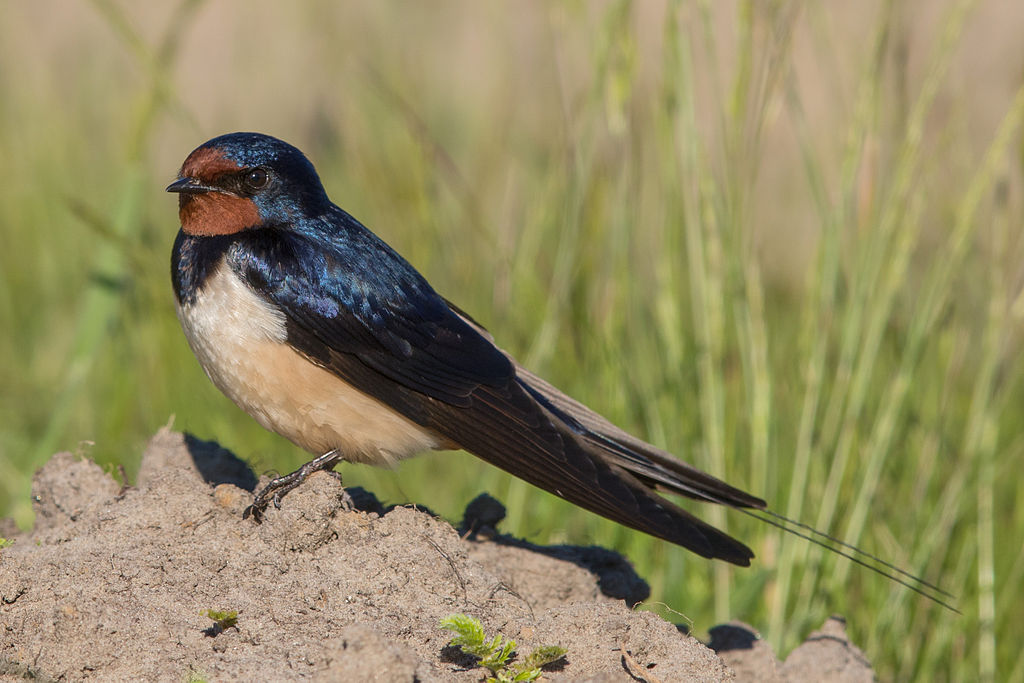
Coloration and Markings: Barn Swallows have deep blue backs and long wings which have a white line at each should and these birds have small tails with long outer feathers that create a deep fork. White spots are present on the underside of the tail but rather hard to spot unless you get a good look. The breast and underbelly of this bird are a cinnamon-orange color and this color is richest between two blue lines that extend from the shoulders like hanging straps for a cape. Facially, this bird has a cinnamon chin and this color extends across the face and terminates just under the cheek, with the exception of some cinnamon above the bill. The remainder of the face is deep blue, excepting a diamond-shaped black mask in front of the bird’s tiny, triangular black bill. Females will have slightly muted color but the same color scheme.
Size: These birds measure in at 5.9 – 7.5 inches in length and have wingspans of 11.4 to 12.6 inches in width.
Habitat: These birds love open spaces, such as meadows or fields, but they prefer to have water nearby whenever possible. As the name suggests, they do nest in places like barns, sheds, and bridges, so keep an eye out and you might just spot a Barn Swallow!
Diet: Barn Swallows primarily eat insects, so you might try putting some dried or live mealworms in your feeder. There have been occasions reported of this bird eating suet as well but this is uncommon.
Yellow-headed Blackbird – Xanthocephalus xanthocephalus
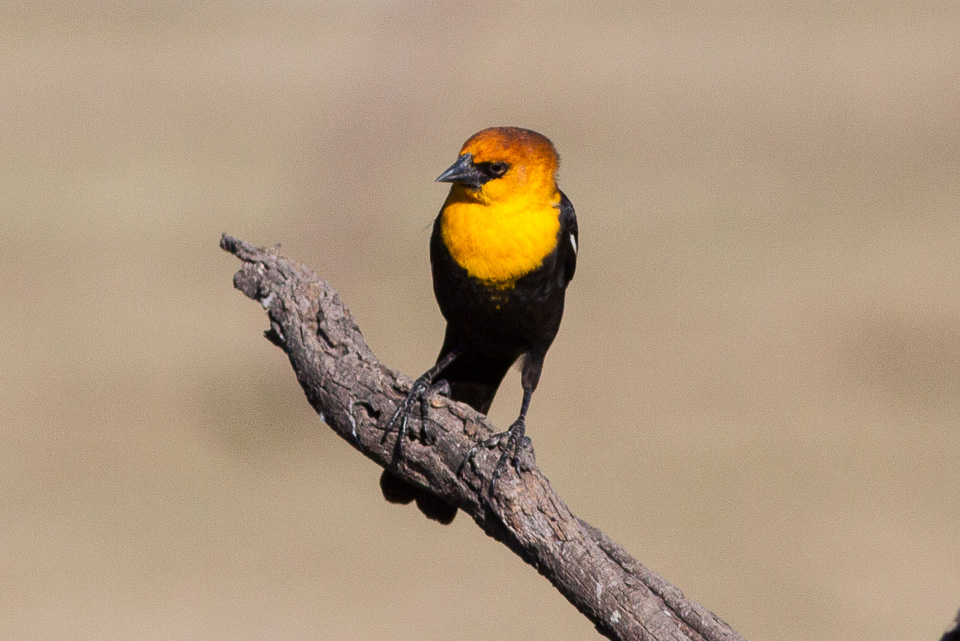
Coloration and Markings: Yellow-headed Blackbirds have black backs, with long, black wings which bear white patches at the bend of each wing. They have long, black tails and their breast and underbelly are ebon as well, though the face and neck will be a shiny yellow that extends down from the face, past the throat, and V’s on the breast. The yellow looks almost like rubber and is often unbroken except for a black mask that terminates just behind the eyes. These birds have long, stout black bills with a slight curvature on the upper bill. Females and juveniles will be brown, rather than black, and while females will have no white at the bend of their wings juvenile males will have traces of it which become more apparent as the bird gets older.
Size: Roughly Robin-sized, these birds measure in at 8.3 – 10.2 inches in length and have wingspans of 16.5 to 17.3 inches.
Habitat: These birds love marshes and are often spotted on cattails in such environments. They do range out into fields and grasslands for foraging, however, and may visit the occasional park or backyard though this is uncommon.
Diet: Yellow-headed Blackbirds like grains and seeds, so leave out some wheat, rolled oats, and Nyjer thistle and you might just earn yourself a visit!
Marsh Wren – Cistothorus palustris

Coloration and Markings: Marsh Wrens have grayish backs with short wings which are a warm brown at the shoulders but gray, with some gray banding and white highlights, towards the tips. They have short, brown tails which are grayish for half of their length and the breast and underbelly of this bird are white with a heavy flanking of brown, especially at the breast. Facially, this bird has a brown face with a large white bib and a large white eyebrow line as well. A thin, gray eyeline is also present and this bird has a gray cap with some brown present towards the front of the head. These birds have medium-length, lightly curved black and yellow bills.
Size: These birds measure in at 3.9 – 5.5 inches in length and have wingspans of approximately 5.9 inches in width.
Habitat: Cattails, sedges, and thickets, these birds live in freshwater wetlands and bounce around happily as the forage where the air is wet and the vegetation is dense.
Diet: If you live close to water than you might lure in a ranging Marsh Wren with some live mealworms but otherwise it is unlikely that they will visit the feeder.
Bullock’s Oriole – Icterus bullockii

Coloration and Markings: Male Bullock’s Orioles have black backs with medium length black wings and tails, with the wings displaying a white patch on each side and the tail showing bright orange on the underside. The breast and underbelly of this bird are orange and facially, this bird has an orange face with a small, black bib, a small, thin black eyeline, and a thin, black crown. These birds have long, thick, and pointy silver bills. Females and juveniles will have a slightly different color arrangement, with a white underbelly and yellowish-orange head, breast, and tail.
Size: These birds measure in at 6.7 – 7.5 inches from tip to tail and have wingspans of approximately 12.2 inches.
Habitat: These birds love open woodland areas, especially if there is a stream or river nearby. Look for them here and especially near Cottonwood, Mesquite, or Oak trees. These birds range out sometimes as well into gardens, orchards, parks, and the occasional backyard with a well-stocked feeder.
Diet: Bullock’s Orioles love suet and fresh berries of just about any kind. Don’t be surprised if you see them sipping from your Hummingbird feeder either, as these birds have a bit of a sweet tooth.
Utah’s Fall and Winter Birds
With winter lows falling down to 3 degrees Fahrenheit, Utah winters might best be referred to as ‘Robust’. Despite the chill, the brave birds below may be spotted outside foraging for snacks to stave off the frigid chill and you can help them out! Be sure to leave out some snacks and maybe even a heated birdbath for these guys and gals this winter:
- Black-capped Chickadee
- Dark-eyed Junco
- Eurasian-collared Dove
- Burrowing Owl
- Blue Jay
Black-capped Chickadee – Poecile atricapillus
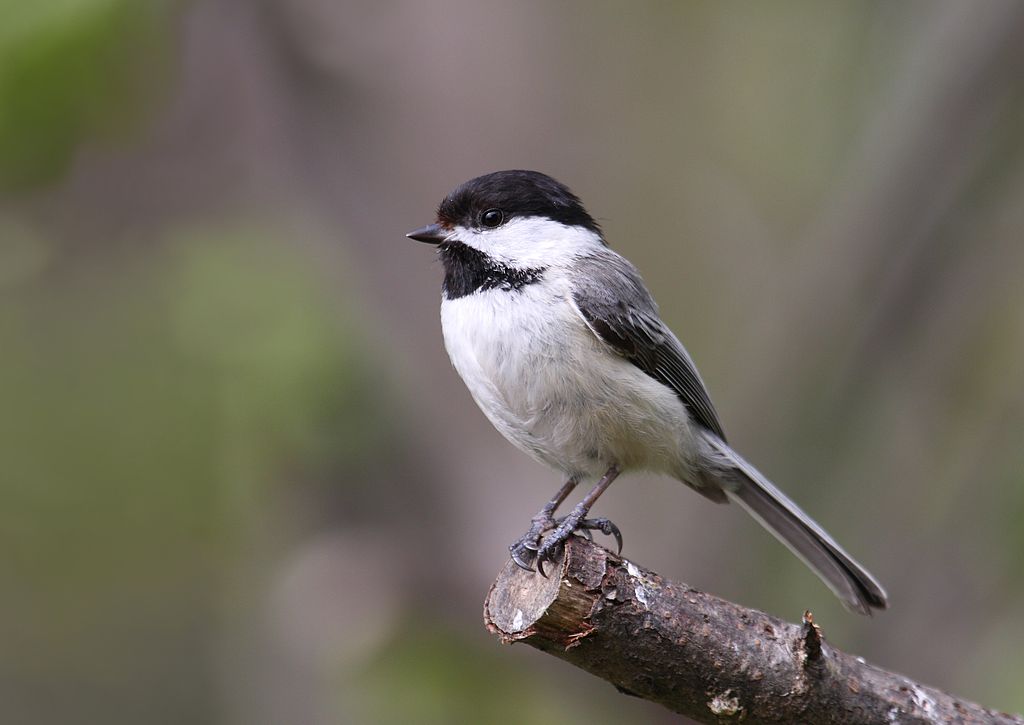
Coloration and Markings: Black-capped Chickadees have soft, silver backs with medium-length silver wings which have some minute white edging as highlights. They have long, thin gray tails with some white outer feathers and the breast and underbelly of this bird are a pure, snowy white as well. Facially, this bird has a small, black bib and a large, black cap that terminates at mid-eye level. The remaining center of the face is bright white and these birds have tiny, triangular black bills.
Size: These birds measure 4.7 – 5.9 inches in length with wingspans of 6.3 to 8.3 inches wide.
Habitat: These birds are comfortable in forest, farm, or city, provided that there is cover nearby in the form of shrub, thicket, brambles, or thorns. These little birds also love cattails in freshwater marshes and overgrown fields where they can feel safely hidden while they forage.
Diet: Suet and peanut butter, either separate or mixed together, is all that you need to get and keep the Black-capped Chickadee’s attentions. Give the mix a try and you will see what we mean.
Dark-eyed Junco – Junco hyemalis

Coloration and Markings: Dark-eyed Juncos come in about 15 different regional flavors *considered to be 15 different races of Junco!), but the standard plumage set is that the bird will have a dark gray or brown back, with medium-length gray wings and a long, gray tail which is white on the undersides. The rump of this bird will be white, but the breast and underbelly will be white with a flanking of gray that becomes heavier as it approaches the breast. This leads to a ‘balanced’ look of vertical coloration, with white being on the bottom 2/3 of the body. Facially, these birds have dark brown or gray heads with medium-length, conical pink bills.
Size: These birds measure in at 5.5 – 6.5 inches from tip to tail and have wingspans of 7.1 to 9.8 inches.
Habitat: When it’s warm Juncos like to spend their time in the woods, preferring coniferous and mixed coniferous woods (in that order). When it gets colder, however, they start foraging a bit further from home and that’s when you can see them just about anywhere. Road stops, fields, parks, and backyards with well-stocked feeders are all fair-game for the foraging Junco.
Diet: Cracked corn, hulled Black Oil Sunflower seeds, and White Proso millet are good either mixed or alone when it comes to getting the Dark-eyed Junco’s attentions.
Eurasian-collared Dove – Streptopelia decaocto
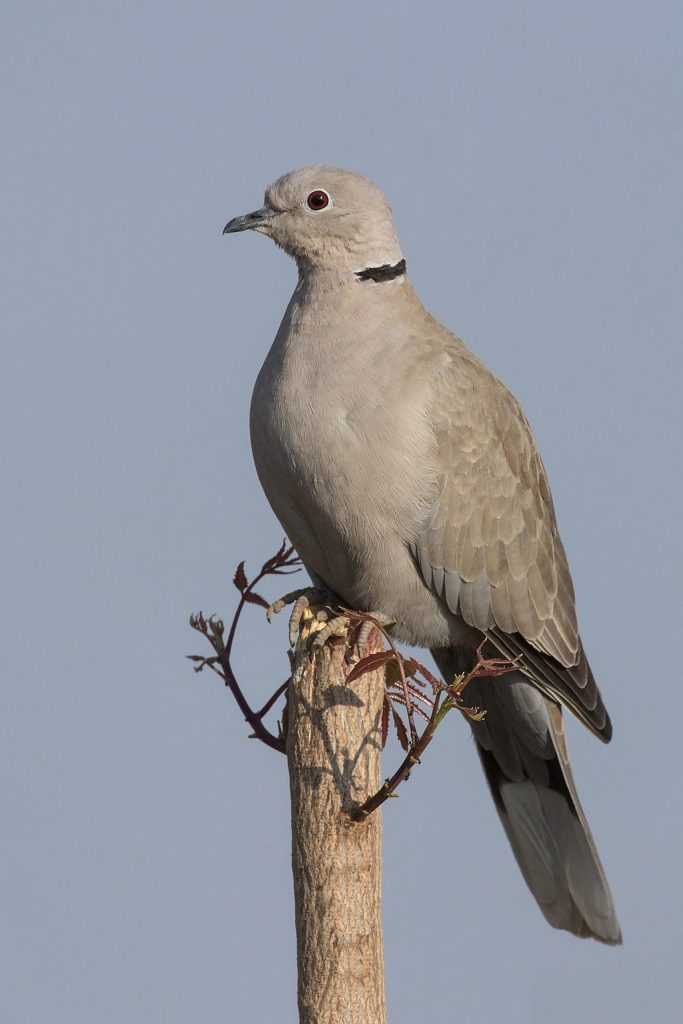
Coloration and Markings: Eurasian-collared Doves tend to be light gray to gray and tan, with long wings which are often black towards the wingtips and long, wide gray tails. The breast and underbelly of this bird will be a gray to tan and gray color and its long neck will be a lighter gray with a black crescent mark on the neck that looks like an old Celtic ‘Torque’ necklace. Facially, this bird is lighter colored towards the lower front of the face while the top of the head and the back of the neck are a darker gray. This bird has a medium length, lightly curved black bill.
Size: These birds measure in at 11.4 – 11.8 inches in length and have wingspans of approximately 13.8 inches.
Habitat: While these birds will visit farms, they are most often found in cities where they boldly forage near roads and in front and backyards. Don’t look for them in the woods as you won’t find them there.
Diet: These Doves love wheat, rolled oats, cracked corn, and even berries if you want to leave out some dessert.
Burrowing Owl – Athene cunicularia

Coloration and Markings: Adult Burrowing Owls have dark brown backs with long, dark brown wings and short brown tails. This brown coloration is heavily mottled with tannish-white spots. The underbelly of this bird will be spotted as well, but white, with the brown tending towards bar patterns. The the breast will simply be spotted brown on white. Facially, this bird has no ear tufts and a brown face with sandy-spots and a long white ‘uni-brow’ mark atop a short, thick and curved silver bill. Juveniles will display less spotting and tend to have yellowish-tan underbellies and a white wing patch on each wing.
Size: This owl measures in at 7.5 – 9.8 inches in length and has a wingspan approximately 21.6 inches wide.
Habitat: These birds love open areas where the vegetation is sparse. Typically they are found in areas where there are squirrels or prairie dogs, as these owls often take advantage of abandoned burrows so that they don’t have to dig their own.
Diet: There is a minute chance that some suet in a ground feeder might get this bird’s attention it is still unlikely. While you can’t tempt them with the feeder so much, you CAN sometimes tempt them by digging out a 1 or 2 foot plug of earth in a nice, bare area of the backyard. This gives them the start for a burrow and if you are lucky you might get your own Burrowing Owl tenant!
Blue Jay – Cyanocitta cristata
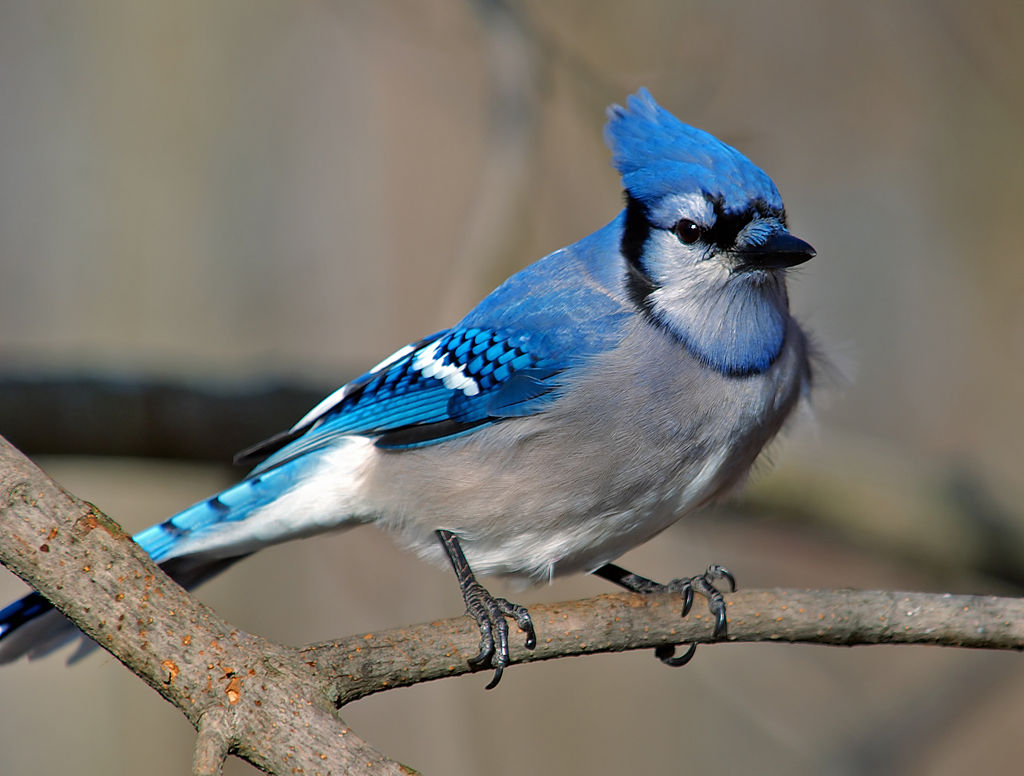
Coloration and Markings: Blue Jays have sapphire blue backs, with medium-length blue wings which display a scaling pattern of blue outlined in black just under the shoulders and towards the center. Large, white spots are also present on the inner-area of the wing and these birds have long, blue tails with a symmetrical pattern of light blue square-pairs outlined in dark blue, with white on the undersides of the tail. The breast and underbelly of this bird are snowy white and this white carries up into the face where it is broken briefly by a black line that encircles the throat and terminates on both sides at the back of the bird’s majestic blue crest. Facially you will also notice a black, somewhat abstract looking mask and this bird has a long, straight, and stout black bill.
Size: These Robin-sized birds measure in at 9.8 – 11.8 inches from tip to tail and have wingspans of 13.4 to 16.9 inches.
Habitat: When Blue Jays are not spending time at the forest’s edge they can be seen around the city, perched on phone lines or fences, or simply munching contentedly at a backyard feeder. These birds do love Oak trees, we should note, as they are particularly fond of acorns.
Diet: Black Oil Sunflower seeds mixed with crushed peanuts are a great and easy way to attract Blue Jays.
Supporting cast (Other Backyard Birds of Utah that might pay you a visit)
As a bonus section we always like to include a few ‘Supporting cast’ birds to our lists. These celebrity feathered friends can be spotted at any time of the year, just like the year-round birds we have listed earlier, and they are well worth keeping an eye out for. See if you can spot one of these supporting cast birds this year:
- Northern Flicker
- House Sparrow
- Killdeer
- Lewis’s Woodpecker
- Gray Jay
Northern Flicker – Colaptes auratus
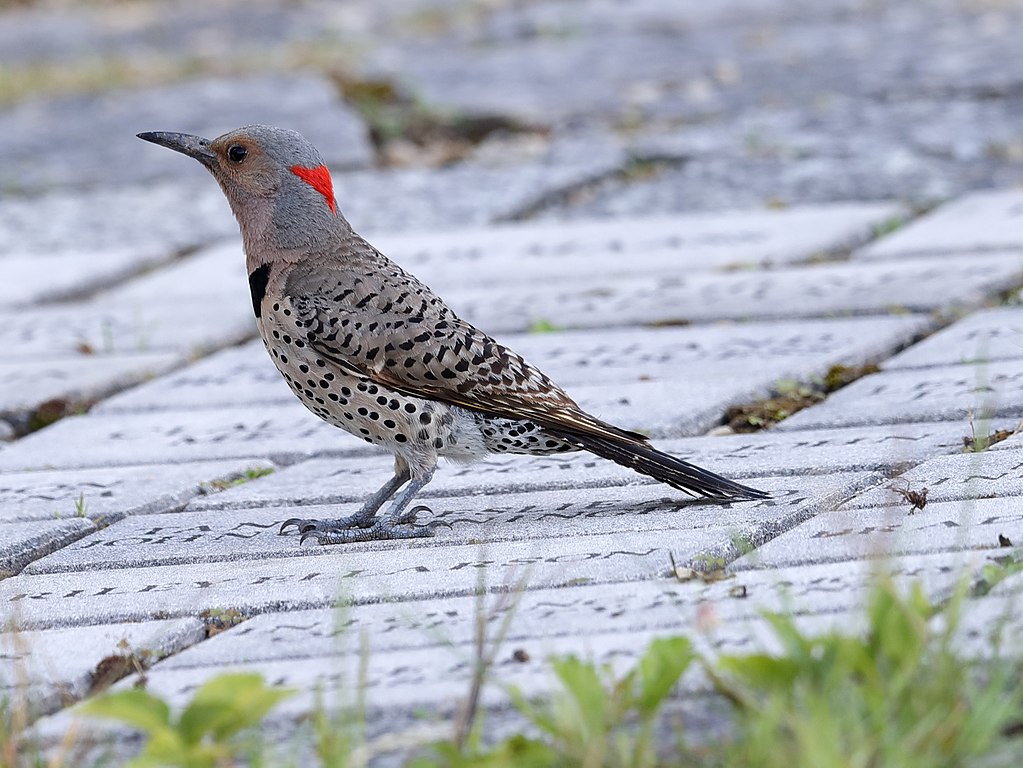
Coloration and Markings: Northern Flickers are colorful Woodpeckers with grayish-brown backs with medium-length grayish-brown wings. They have short grayish-brown tails as well and assorted black markings will pepper the whole of the upper body. The underside of the tail will typically be a bright yellow or red color and the breast and underbelly of this bird are a smooth mix or gray and white with black spots. At the top of the breast is a distinctive black crescent mark under a long, silver neck. Facially, this bird has a gray face with a red cheek line and a brown eyeline that travels diagonally up and terminates just behind the eye. This bird has a long, slightly curved black bill and we should note that on some birds the area around the cheeks, the throat, and the underside of the bill may be tan.
Size: These birds measure in at 11 – 12.1 inches in length and have wingspans of 16.5 to 20.1 inches.
Habitat: These birds love open wooded areas so look for them in meadows, clearings, and copses and you might catch a lucky glimpse. They do range out into parks and backyards, however, so leaving a little something out might just bring a Northern Flicker to YOU.
Diet: Try leaving out a mix of suet, peanuts, and dried apricots. Northern Flickers seem to LOVE this mix and can’t seem to get enough.
House Sparrow – Passer domesticus

Coloration and Markings: House Sparrows have buff to dark brown backs with black streaking present. They have small wings and medium-length tails of the same color and the breast and underbelly of this bird are a ‘sooty white’ mix of grays and whites. Towards the upper breast you will see a heavy peppering of black which comes down from the bird’s bib and beyond this, the lower half of the face will be white. This includes the base of the throat across to the back of the head and white outlines the cheeks as well. This bird has a large eyestripe that starts out black but becomes a wide, brown stripe at the back of the eyes which curves in to frame the cheek. The crown of this bird is silvery-gray and it has a short, thick, and lightly curved black bill. Females tend to be a paler buff-brown and will display heavier streaking and have brownish-gray lower bodies.
Size: These birds measure in at 5.9 – 6.7 inches in length and have wingspans of 7.5 to 9.8 inches.
Habitat: House Sparrows said goodbye to the forest a long time ago and they’ve been hanging around us ever since. Look for them in farms or around the city where they are scoping out potential meals from nearby roofs, fences, or phone lines.
Diet: Black Oil Sunflower seeds and suet cakes are one of the easiest and best combos for attracting the House Sparrow.
Killdeer – Charadrius vociferus

Coloration and Markings: Killdeers look like jolly little pirates! They have light brown backs with long wings and long tails with some white on the undersides coming from the rump. The underbelly and breast of this bird are paper-white though you will see 2 distinct black stripes at the top of the breast. The face of this bird is mostly white, however you will see some gray at the crown and at the cheek area. A black eyeline stripe also starts from the crown and goes diagonally to the front of the eye and emerges as a thin, black line at the back of the eye that curls down slightly and terminates close to the back of the head. This looks rather like a pirate’s eyepatch. These birds have straight, medium-length black bills.
Size: These birds measure in at 7.9 – 11 inches in length and have wingspans of 18.1 to 18.9 inches from wingtip to wingtip.
Habitat: These birds love to forage in open areas of ground, bare or otherwise. You can spot them in parking lots, golf courses, lawns, and front or back yards. They can also be found around mudflats or sandbars but this bird tends to range out quite often so keep an eye out and you might a Killdeer looking for its lunch.
Diet: While these birds primarily dine on insects and crustaceans they do eat small seeds and fruit, so try leaving out some Nyjer thistle and some chopped apples or whole raisins. Put them in a ground feeder for best results.
Lewis’s Woodpecker – Melanerpes lewis

Coloration and Markings: Lewis’s Woodpecker has a dark, greenish-black back and long wings and tail of the same color. The breast and underbelly of this birds are a lovely pink and the breast and face will be separated by a thick, silver collar. Facially, this bird has a black head but with dark red at the cheek, in front of the eyes, and just under the bill. This bird has a long, stout, and straight black bill.
Size: These birds measure in at 10.2 – 11 inches in length and have wingspans of 19.3 to 20.5 inches.
Habitat: These birds love open, wooded areas, especially is there are Pine or Oak trees about. They like to be near water as well whenever possible. They sometimes range out to visit parks, gardens, and the occasional backyard.
Diet: Leave out a little suet and peanut butter and you might just get the attentions of Lewis’s Woodpecker.
Gray Jay – Perisoreus canadensis
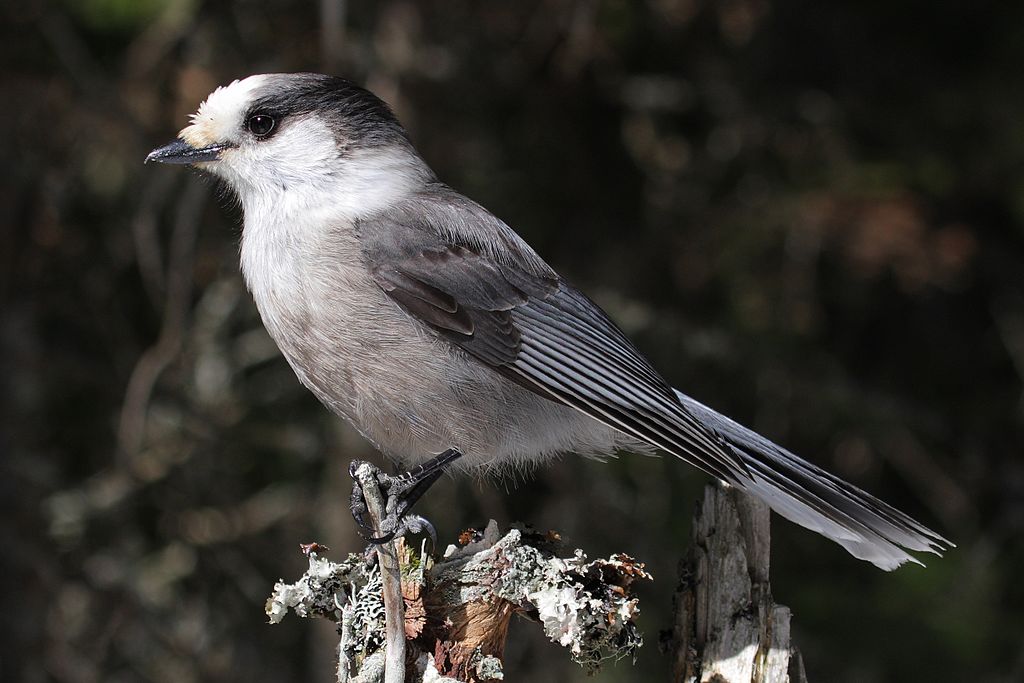
Coloration and Markings: Also known as ‘Canada Jays’, Gray Jays have dark gray backs, with long, pointy gray wings and long, perky gray tails. The undersides of the tail will be a lighter gray, as is the underbelly and breast of this bird. Facially, this bird has a mostly white face and that white extend down past the throat to make a V-shape at the top of the breast. You will notice a wide swath of gray coming from the back of the eye that goes to the back of the head which carries down towards the base of the throat and upwards as well, terminating at the white forehead. You may notice a small touch of salmon color just above the small, stout, and conical black bill.
Size: Roughly Robin-sized, this bird measures in at 9.8 – 11.4 inches in length with a wingspan of approximately 18 inches in width.
Habitat: Gray Jays love evergreen or mixed evergreen-deciduous woods. They do range out into parks from time to time, however, so stock up that feeder and you might just get a visit!
Diet: Also known as ‘Camp Robbers’ for their habit of hanging around campsites to loot human snacks, these birds can be tempted with a lot of different foods. Fresh or dried fruit is good, as well as suet, and peanuts are always welcome. Just keep a close eye on your sandwich if you are out camping, otherwise you’ll be eating those peanuts yourself!
Utah Bird Buffet
Utah birders face a difficult challenge. With 466 species out there, how do you select the combination of feeder food that will appeal to the widest range of birds without adding way too many feeders? Today we’ve got some suggestions from Utah Valley Gardens as well as a few of our own to get you started on finding that perfect combination. If you want to read the full article from Utah Valley Gardens just be sure to check our reference links and in the meantime, here are some foods you should consider adding to your feeders or home garden if they aren’t already present:
- Peanut butter and grape jelly
- Suet
- Black Oil Sunflower
- Bayberry (add to your garden)
- Elderberry
- Purple Coneflower
Utah Birding Hot spots
The Chirparazzi have scoured the length and breadth of Utah looking for the best places to catch a glimpse or even a photo of Utah’s winged stars. Today, we’re sharing that info, with some spots around the compass points where you can see your favorite Avian species happily at home in their native elements. See if you can visit one of these hotspots this year:
- Northern hotspot – Prospector Rail Trail
- Eastern hotspot – Moab Canyon Pathway
- Southern hotspot Bryce Canyon Shared Use Path
- Western hotspot – Coal Creek Trail (UT)
- Central hotspot – Candy Mountain Express Bike Trail
Detailed descriptions of each location as well as information regarding visiting and what birds you can see at these locations may be found at https://www.traillink.com/stateactivity/ut-birding-trails/
Some Closing Words
Today we’ve taken some tentative steps into the long, long trail of Utah birding. While we’ve only touched on the smallest portion of the species out there we hope that you’ve found a useful tip or two here that will help you in that neverending quest to see as many of these lovely birds as you can. Until next time, keep your binoculars close and keep your patience closer, because you’ve got a lot of birds just waiting to be spotted in the beautiful state of Utah!
